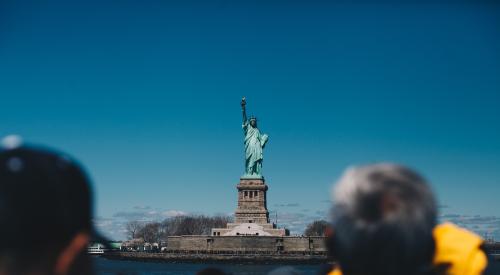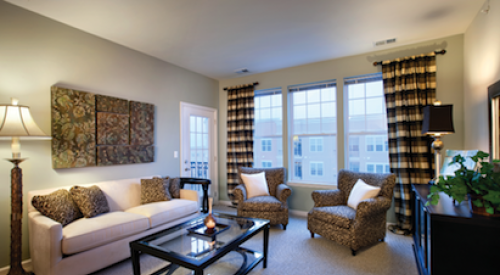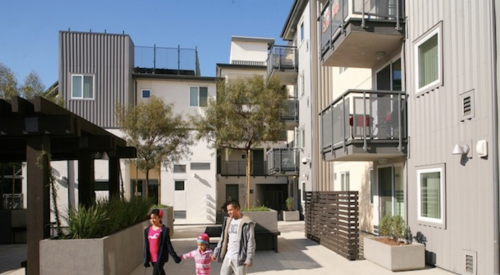One of the most important - and most sensible - principles of green building is developing in areas that already have the necessary infrastructure and public transportation systems in place. But green building programs around the country deal mostly with single-family homes - the kinds of homes that most Americans want - and low-density, multifamily buildings averaging only two to three units.
And since rentals and condos are what most builders build in those very urban areas that do get developed, there are no end-users asking for energy efficiency or low VOC paints. In these cases, green means expense and hassle, and if there isn’t someone to demand it, builders see no reason to cut their margins by volunteering it.
| Battery Park City, where six new green high-rise apartments will be built, sits at the southwestern tip of Manhattan in the shadow of Wall Street and the World Trade Center. Photo by Stan Ries.
|
But what if building green was not an option, but a requirement? Usually that word implies limits, but in New York City there is some pretty stiff competition to get the chance to build high-rise apartments on six sites in the much sought-after Battery Park City - despite some very specific green requirements.
Battery Park City, located at the southern tip of Manhattan, is a strip of land that was created in the early 1960s when the excavated dirt and rock from the site of the neighboring World Trade Center was dumped where 20 piers on the Hudson River used to stand. No longer important to shipping, the area became a 92-acre landfill and was master planned in 1969 (and revised in 1979). In the 40 years since it has become its own little city, with residential, shops, restaurants, schools, rapid transit and parks, and it is home to the World Financial Center, the Mercantile Exchange and the Museum of Jewish Heritage.
There are few sites left to develop at Battery Park City, but the Hugh L. Carey Battery Park City Authority (BPCA), the public benefit corporation created in 1968 by the state legislature to oversee it, decided they should be developed with environmental concerns and future occupants’ health in mind.
The BPCA recently worked with Fox & Fowle Architects, notable for creating the Condé Nast at Four Times Square office building, to develop green guidelines for residential building at Battery Park City. According to the BPCA, the purpose of these requirements is "to establish a process for the creation of environmentally responsible residential buildings that are appreciably ahead of current standards and practices for development."
Last January New York Governor George E. Pataki issued a Request for Proposals (RFPs) for the development, saying that he was proud that Battery Park City is creating a public/private initiative to build the first comprehensive green high-rise residential building in the northeast - and possibly in the nation.
"This hi-tech high rise will not only reduce harmful emissions, it will also reduce electric bills and operational costs. These vital goals will be achieved through the use of recaptured ‘gray’ water, daylight dimming systems, double glazed windows, landscaped roof gardens that reduce heat gain and loss and renewable technologies such as integrated photovoltaic panels and fuel cells."
The authority has chosen Albanese Development Corporation to build the 26-story, 337,000 square foot apartment building on the first site. Nine other companies submitted proposals for the 18,000 square foot site.
Sky-High Green Guidelines
"We proposed a dramatic step up from the state of residential building in the city," says Peter Weingarten, AIA of Fox & Fowle. With these green guidelines, he adds, developers must "do things [they’re] not accustomed to doing in New York City, like energy efficiency, air quality and water conservation."
The requirements set forth are prescriptive by nature, and each proposal submitted by developers must address how they would meet each requirement. Albanese Development’s solution, for instance, to the requirement that the building had to achieve a 30% reduction in energy use over the state energy code was a central chilled and heated hot water system for heating and cooling fueled by a natural gas absorption chiller.
The requirements cover five major categories: energy efficiency, indoor environmental quality (IEQ), material and resource conservation, operations and maintenance and water conservation and site management. Each category is then broken down into specific requirements suited to its high-density, multifamily purpose.
Drafting the BPCA Residential Environmental Guidelines was a challenge, says Weingarten, because the document is really the first of its kind. Much of what can be found in local HBA-sponsored green building programs proved inapplicable to Battery Park’s unique situation, and the proposed high rises fall somewhere between USGBC’s LEED (Leadership in Energy and Environmental Design) Commercial rating system and the LEED Residential system, which is still in the development stages.
According to Russell Albanese, building to these requirements will be a challenge, but he thinks the finished product will be worthy of LEED certification. To this end, Albanese Development has amassed a team of architects, designers, engineers and consultants with expertise in the design and implementation of environmental systems in both commercial and residential applications.
"We have a lot of experience in multifamily and some of our commercial projects have some high energy efficiency features and green technologies," says Albanese. "But this is the first entirely green building [that we’ve done] that will be going for a LEED rating."
The 250-unit high rise is estimated at $95 million, and construction is due to begin in early 2001 and be finished in late 2002. The Battery Park City Authority has already sent out RFPs for the next two developments.












